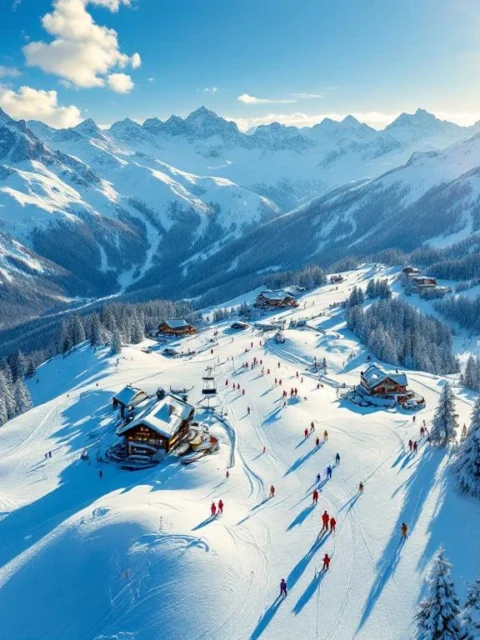How to Make Your First Turn on Skis?

The first turn on skis. A magical moment for every beginning skier! You’re standing at the top of a (mini) slope, your heart racing, and then it’s time to get moving. But how do you actually do that? How do you ensure that you make that first turn not only safely but also with confidence? In this article, we’ll help you with practical tips and explanations that you can apply immediately. Whether you’re completely new to the snow world or getting back on skis after years, these guidelines will help you make those first turns with more confidence and enjoyment.
The Correct Posture for Your First Turn
A good skiing posture is the foundation for every successful turn. Think of your posture as the foundation of a house – without a solid foundation, everything collapses. But don’t worry, you’ll quickly learn the right posture!
Start with your feet approximately hip-width apart. Your knees are slightly bent, not locked. This is the basic position where everything begins. Bend from your ankles and knees so that your shins press lightly against the front of your ski boots. This gives you more control over your skis.
Your upper body should be upright, not leaning forward or backward. Imagine there’s a string attached to the top of your head pulling you upward. Your arms are relaxed and slightly bent in front of your body, as if you’re holding a large tray.
Weight distribution is very important: ensure your weight is evenly distributed over both skis. Your weight should rest on the middle of your feet – not on your toes or heels. If you lean too much on your heels, you’ll lose control and go faster than you want.
Always look in the direction you want to go. Your body will automatically follow your gaze! So don’t look at your skis (however tempting), but at the point where you want to glide to.
Basic Movement of the First Turn
Now that you know how to stand, it’s time to get moving. The first turns you learn are usually snowplow turns. With this technique, your skis are in a V-shape (the ‘pizza slice’ or ‘snowplow’), which allows you to control your speed.
Let’s go through the basic movement step by step:
- Start in the snowplow position (skis in V-shape) on a gentle slope
- Make sure your weight is evenly distributed over both skis
- To make a right turn, gradually shift your weight to your left ski (the outside ski in the turn)
- To make a left turn, shift your weight to your right ski
Steering happens primarily with your feet and legs, not with your upper body. Think about pressing with your big toe for a right turn and with your little toe for a left turn. Your inside ski (the ski on the side you’re turning toward) has less pressure than your outside ski.
While making a turn, it’s important to keep your upper body stable. As your lower legs steer, your upper body remains calm and facing forward. This gives you balance and control.
You determine the speed of your turn with the width of your snowplow. The wider the V-shape, the slower you go. As you gain more confidence, you can make the snowplow less wide for a bit more speed.
First practice with very gentle, wide turns. Once this goes well, you can gradually transition to somewhat tighter turns. Patience is key here – give yourself time to develop the feel.
Common Mistakes for Beginning Skiers
Every beginning skier makes mistakes – it’s part of the process! Being aware of these pitfalls helps you progress faster. Here are the most common mistakes and how to avoid them:
Leaning Backward
This is perhaps the number one mistake. When you lean backward, you lose control of your skis and your speed increases. It might feel safer to shift your weight backward, but the opposite is true!
Solution: Focus on feeling your shin against the front of your ski boot. Think of the posture of a soccer player ready to receive the ball.
Putting Too Much Weight on the Inside of the Ski
Many beginners put too much pressure on the inside of their skis, giving you less grip and making it easier to slide away.
Solution: Try to consciously feel how you stand on the entire sole of your foot, with slight pressure towards the outside of your foot during the turn.
Skiing Stiffly or Tensely
Tension in your body makes it harder to move fluidly and adapt to the terrain.
Solution: Between runs, shake out your arms and legs. Breathe consciously in and out while skiing. Think of dancing on the snow, not surviving!
Being Too Hasty
Many beginners want too much too quickly. They try to go faster or tackle more difficult slopes before mastering the basic technique.
Solution: Take time to really master the basics. A good foundation makes all subsequent steps easier. Read more about the right pace in ski lessons.
Not Looking Far Enough Ahead
If you only look at your skis or the snow right in front of you, you’ll react too late to what’s coming.
Solution: Always look at least 3-5 meters ahead in the direction you want to go. Your body will follow automatically!
From Snowplow Turn to Parallel Turn
When you’re comfortable with the snowplow turn, the next step is toward the parallel turn. This is where real skiing begins! The transition isn’t something you’ll learn in one day – it’s a gradual process where you progressively shift from snowplow to parallel.
Here are some exercises to help you make this transition:
Reducing the Snowplow
Start by making your familiar snowplow turns, but try to make the V-shape of your skis progressively smaller. You’ll notice that this makes you go a bit faster, but also that you gain more control over the movement.
The Hokey-Pokey
During a gentle descent in snowplow, briefly lift your inside ski (the ski on the side you’re turning toward) during the turn. This teaches you to trust your outside ski, which is crucial for parallel turns.
The Flying Start
Begin your descent with parallel skis. Only make a snowplow when you initiate the turn. After the turn, bring your skis back to parallel. This way you alternate between parallel and snowplow.
The Accordion Turn
Start your turn in snowplow and finish the turn by bringing your skis back to parallel. Repeat this for the next turn. You move like an accordion between snowplow and parallel.
Remember that this transition takes time. Some skiers take a few days, others a few weeks. The most important thing is to keep enjoying yourself while learning!
With each new technique, it’s wise to return to an easier slope. This allows you to safely experiment without the stress of a too steep or crowded slope.
The key to a good parallel turn lies mainly in the edging movement and shifting your weight. Instead of ‘pushing’ with your skis (as with the snowplow), you’ll ’tilt’ them more to steer.
If you find yourself stuck in your development, a lesson from a ski instructor can work wonders. A few targeted tips can be exactly the push you need to break through to the next level.
Those first turns on skis are the beginning of a beautiful adventure in the mountains. At Ski-Pro, we understand how important it is to master the basics well. That’s why we work with ski instructors who know exactly how to help you take those first important steps on the slope. Whether you choose private lessons or group lessons, with the right guidance you’ll quickly develop a good technique that greatly enhances your skiing pleasure. Because ultimately, that’s what it’s all about: enjoying the mountains, the snow, and the wonderful feeling of gliding!
Frequently Asked Questions
How long does it usually take to comfortably make turns as a beginner?
Most beginners can develop basic turning technique within 2-3 ski days. It varies per person, but with 2-3 hours of practice per day, you can usually make comfortable snowplow turns within two days. Parallel turns take an average of 5-7 ski days. Remember that consistent practice is more important than rapid progress – take the time to master each step well before moving on.
What should I do if I panic during a turn and fall?
Panic moments are normal for beginners! If you feel like you're losing control, focus on your basic position: knees bent, weight forward, and widen the snowplow to reduce speed. If you do fall, try to stay 'small' by keeping your limbs close to your body and not using your hands to break your fall. After a fall, take a moment, analyze what happened, and start again at an even slower pace. Every fall is a learning moment!
How can I practice at home to improve my skiing technique?
There are various exercises you can do at home: balance on one leg to improve your stability, do squats for leg strength, and practice with a balance board to train your sense of balance. You can also 'dry practice' your turning technique by slowly going through the movements and imagining yourself on the slope. Watching video training also helps – there are excellent YouTube tutorials showing what a perfect turn looks like from different angles.
Which specific muscle exercises help improve my skiing technique?
Focus on your quadriceps (thigh muscles), hamstrings, calves, and core muscles. Squats, lunges, and wall-sits are excellent for leg strength. Plank exercises strengthen your core, which is essential for balance. Single-leg exercises like one-leg deadlifts improve your stability. Start 6-8 weeks before your ski trip with 2-3 training sessions per week for the best results. Balance exercises on unstable surfaces also train the small stabilizing muscles that you use a lot during skiing.
How do I know when I'm ready to move to a more difficult slope?
You're ready for a more difficult slope when you can descend consistently and controlled without unwanted accelerations or frequent falls. You should be able to control your speed at all times and make both left and right turns with confidence. A good rule of thumb: if you descend a slope three times in a row without problems and even feel a bit bored doing so, it's time to move up a level. When in doubt, ask advice from a ski instructor!
What are the best exercises to overcome fear of speed?
Start with 'traversing' (sliding sideways across the slope) to become comfortable with your skis. Then practice short stretches of straight gliding with a snowplow stop at the end. Gradually increase the distance. Visualization techniques also help: imagine what a successful descent looks like before you start. Breathing exercises can reduce anxiety; try to breathe in deeply before you depart and exhale calmly while skiing. Finally, an experienced ski instructor can give you specific confidence exercises tailored to your level.
How can I best deal with different snow conditions as a beginning skier?
As a beginner, it's advisable to stick to well-groomed slopes (corduroy) - you can recognize these by the grooved patterns in the snow. In icy conditions, it's important to make your turns wider and put extra pressure on the outside ski for more grip. In fresh, soft snow, you can stand more upright and make wider movements. Powder snow is challenging for beginners - wait until you have more experience. Always follow the advice of local ski instructors about the best slopes given the daily snow conditions.


